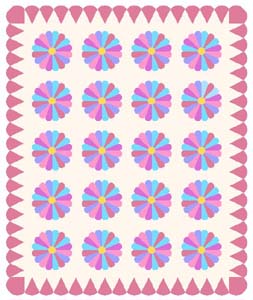The Story of Colonial Revival Quilt Patterns
"A new and artistic note has been achieved in these designs for hand-made quilts of applied patchwork. The aim has been to make them practical as well as beautiful�" 1 Ladies Home Journal, 1911
The Centennial Exhibition of 1876 was held in Philadelphia, Pennsylvania to celebrate the 100th birthday of the United States. Although this grand world's fair showcased the United State's industrial accomplishments it also reminded Americans of their origins. As interest in the past grew the Colonial Revival was born.

At the same time the Arts and Crafts movement in both Europe and America encouraged going back to a bygone way of living in contrast to the modern industrial culture.
Architecture and room decoration moved from the elaborate styles of the Victorian era to simpler design based on the homes and furniture of an earlier era. (Imagine the difference between the busyness of a Victorian crazy quilt and the balanced symmetrical lines of a pieced block quilt.) Hand made items were idealized not only for their beauty but because of the values they represented.
Although this movement began at the end of the 19th century it was not until the early 20th century that this movement triggered a corresponding Colonial Revival in quilting.
Leaders in the movement already valued the craftsmanship of hand-made household items. Furniture designer, Gustav Stickly, promoted the lines of earlier architecture and furniture. He believed this should be carried out in all home d�cor and admired the "bold and simple" lines of traditional patchwork. 2
 The quilts that were made during the first decades of the 20th century were not reproductions of quilts made 100 years earlier but rather a popularization of the quilt patterns that designers and publishers imagined that colonial women made. In truth the quilts designed and made in response to the Colonial Revival were more like those made during the latter 19th century.
The quilts that were made during the first decades of the 20th century were not reproductions of quilts made 100 years earlier but rather a popularization of the quilt patterns that designers and publishers imagined that colonial women made. In truth the quilts designed and made in response to the Colonial Revival were more like those made during the latter 19th century.
Ladies Home Journal editor, Edward Bok, helped popularize the Arts and Crafts philosophy by publishing everything from home design to quilt patterns in his magazine. As a part of this he published many of Marie Webster designs. 3
 Marie Webster designed her quilts to harmonize with Colonial Revival style homes and women were eager to make quilts like hers to decorate their own homes. Gardening was considered one way to go back to the lifestyle of early Americans and Marie Webster not only nurtured her lovely flower garden but also based many of her quilts on individual flowers. As appliqu�d quilts were the valued for special occasions in earlier times appliqu� was a major design element in her quilts.
Marie Webster designed her quilts to harmonize with Colonial Revival style homes and women were eager to make quilts like hers to decorate their own homes. Gardening was considered one way to go back to the lifestyle of early Americans and Marie Webster not only nurtured her lovely flower garden but also based many of her quilts on individual flowers. As appliqu�d quilts were the valued for special occasions in earlier times appliqu� was a major design element in her quilts.
Some of the popular patterns used in the early decades of the 20th century were new designs born of the renewed enthusiasm for quilts. The Dresden Plate, Double Wedding Ring and the arrangement of hexagons making Grandmother's Flower Garden were the most commonly made patterns during this period. 4 The delightful Sunbonnet Sue that we are all so familiar with was another popular motif that originated during this period.
Depression Era Quilts
� 2007 Judy Anne Breneman
print a printer friendly version of this page1 p20, 2 p17, 3 p19, "A Joy Forever: Marie Webster's Quilt Patterns", by Rosalind Webster Perry & Mary Frolli
4 p94, Soft Covers for Hard Times: Quiltmaking and the Great Depression, by Merikay Waldvogel






